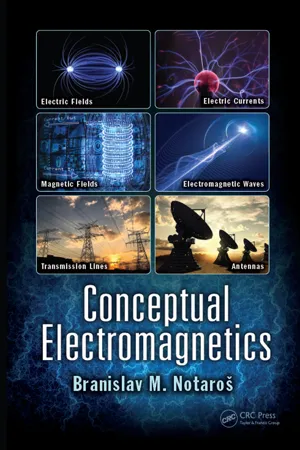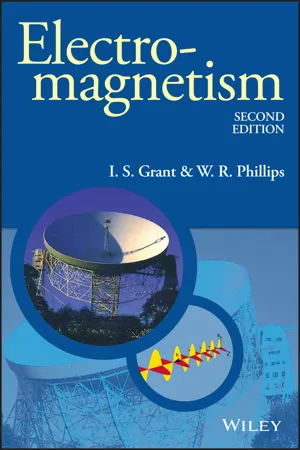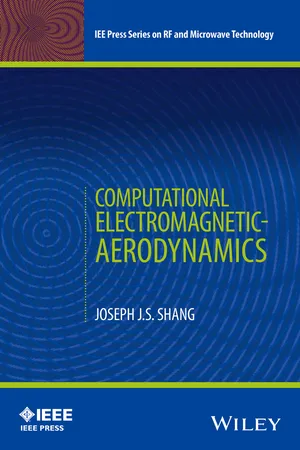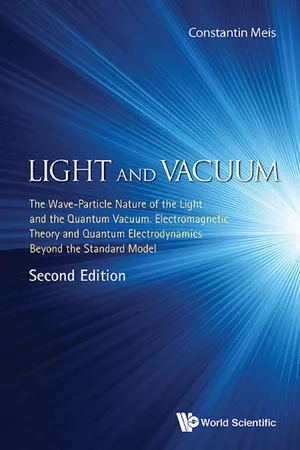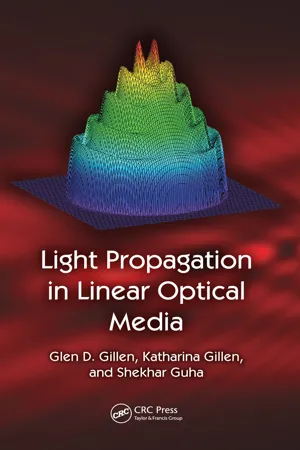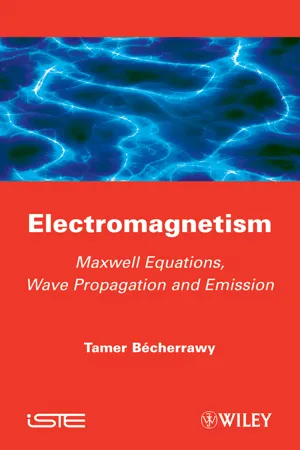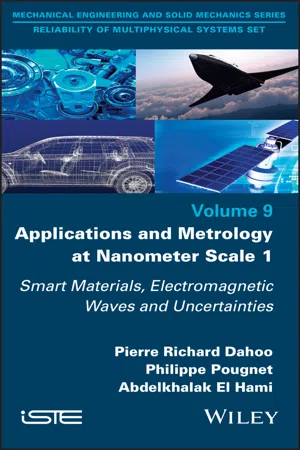Physics
Plane Electromagnetic Wave
A plane electromagnetic wave is a type of electromagnetic radiation that propagates through space in a waveform characterized by electric and magnetic fields oscillating perpendicular to each other and to the direction of wave travel. These waves travel at the speed of light and are fundamental to the understanding of light, radio waves, and other forms of electromagnetic radiation.
Written by Perlego with AI-assistance
Related key terms
Related key terms
1 of 4
Related key terms
1 of 3
10 Key excerpts on "Plane Electromagnetic Wave"
- eBook - ePub
- Branislav M. Notaroš(Author)
- 2017(Publication Date)
- CRC Press(Publisher)
UNIFORM Plane Electromagnetic WaveS IntroductionElectromagnetic waves, i.e., traveling electric and magnetic fields, are the most important consequence of general Maxwell’s equations, discussed in the preceding chapter. We now proceed with analysis of electromagnetic wave propagation, to describe the properties of waves as they propagate away from their sources – rapidly time-varying currents and charges in a source region, such as the one in Figure 6.42(a) , which is simply a transmitting antenna. Far away from it, the elementary spherical waves originated by the sources form a unified global spherical wavefront, which – if considered only over a receiving aperture (e.g., at the receiving end of a wireless link) – can be treated as if it were a part of a uniform plane wave. Such a wave has planar wavefronts and uniform (constant) distributions of fields over every plane perpendicular to the direction of wave propagation. Most importantly, we can completely remove the spherical wave from the analysis and assume that a uniform plane wave illuminating the aperture exists in the entire space. Once this model is established, we then deal with uniform plane waves only, and study their propagation not only in unbounded media with and without losses (this chapter) but also in the presence of planar interfaces between material regions with different electromagnetic properties (next chapter).7.1 Wave EquationsWe consider an electromagnetic wave whose electric and magnetic field intensity vectors are E and H, respectively, in an unbounded region filled with a linear, homogeneous, and lossless (σ = 0) material of permittivity ε and permeability μ, which is assumed to be source-free (J = 0 and ρ = 0), and use general Maxwell’s equations in differential form, Eqs. (6.13) . These are first-order partial differential equations with spatial coordinates and time as independent variables and E and H as unknowns (unknown functions, to be determined, of space and time). They can be combined, taking the curl of Maxwell’s first equation and substituting the expression for ∇ × H from the second equation and ∇ · E = 0 from the third one, to give a second-order partial differential equation in terms of E alone. In an entirely analogous fashion, starting with the curl of Maxwell’s second equation, we can obtain a second-order partial differential equation in H - eBook - ePub
- I. S. Grant, W. R. Phillips(Authors)
- 2013(Publication Date)
- Wiley(Publisher)
x -axis, can be represented by the real part of the expression(11.9)The field has the same amplitude E 0 everywhere, and at all points with the same z -coordinate, i.e. all points in any plane parallel to the x–y plane, the field has the same phase. It is oscillating with angular frequency ω . It can readily be shown that the expression (11.9) is a solution to the wave Equation (11.6) , and hence, repeating the arguments which followed Equation (11.7) in the last section, the speed of propagation of the wave, c , is given by(11.10)k is called the wavenumber , and is measured in m−1 . Figure 11.2 shows how the field varies with time at a fixed position z = 0, and how it varies with position at time t = 0. The variation with distance is sinusoidal, and the distance between equivalent points on successive cycles is equal to the wavelength λ of the wave,(11.11)Figure 11.2 . The top figure shows how the electric field in the plane wave (11.9) varies with time at all points with coordinate z equal to zero. The field is independent of coordinates x and y . The centre figure shows how the field varies with z at time t = 0. The bottom figure shows the variation with z at a later time δt . The wave crests have moved forward a distance δz equal to ω δt /k .The third diagram in Figure 11.2 shows how the field varies with z at time δt . The waveform has the same shape, but the maxima have moved forward a distance δz - eBook - ePub
- Joseph J. S. Shang(Author)
- 2016(Publication Date)
- Wiley-IEEE Press(Publisher)
CHAPTER 5 Electromagnetic Wave Propagation and Scattering Introduction An electromagnetic wave is a transverse wave and is generated by electric charge excitation. The wave is associated with synchronized electric and magnetic fields that oscillate perpendicularly to each other. The direction of wave propagation is perpendicular to the direction of energy transfer. In free space, its phase velocity has a constant value of speed of light. According to the Maxwell equations, a spatially varying electric field is directly linked to a temporally varying magnetic field. Conversely, the magnetic field change in space is associated with an altered electric field in time. It is important to know that the electric and magnetic fields are vibrating orthogonally from each other in phase but both reaching maxima and minima at the same points in place. The coexisting fields occur simultaneously and are linked by the theory of special relativity. In fact, the magnetic field is considered as a relativistic distortion of the electric field. The wave speed is the product of wavelength and frequency, u = f λ. For practical purposes, the electromagnetic spectrum is divided into radio waves, microwaves, infrared, visible light, ultraviolet, x-rays, and gamma rays. The very long wavelength of radio wave is in the tens of meters and the very short wavelength gamma ray is smaller than an atomic nucleus. The solutions to the Maxwell electromagnetic wave equations have often been classified as the plane waves and spherical waves (Jordan, 1960). The former is not but a limiting case of the latter at a very large distance from the source of the wave generator. Like all waves, an electromagnetic wave can be constructed by any number of monochromatic wave components with a single frequency, amplitude, and phase - eBook - ePub
Light And Vacuum: The Wave-particle Nature Of The Light And The Quantum Vacuum. Electromagnetic Theory And Quantum Electrodynamics Beyond The Standard Model (Second Edition)
The Wave–Particle Nature of the Light and the Quantum Vacuum. Electromagnetic Theory and Quantum Electrodynamics Beyond the Standard Model
- Constantin Meis(Author)
- 2017(Publication Date)
- WSPC(Publisher)
c. denoting the complex conjugate part.From (3.2.12 ), (3.2.17 ), (3.2.21 ) and (3.2.22 ), we deduce the Helmholtz equation for each component of the electric fieldIn other words, in the classical electromagnetic theory, the electric and magnetic fields oscillate perpendicularly along the propagation axis k with an angular frequency ω at the speed c/n.This is called simply a plane wave solution. In this representation the wave vector in vacuum (n = 1) has the simple expressionwhere λ is the wavelength, representing the spatial distance of a complete oscillation of the electric and magnetic field vectors over a period T and , the unit vector along the propagation axis.For a given fixed value of the angular frequency ω, and the wave-length λ, the wave is called monochromatic (single color) and we will use the notations and for the corresponding electric and magnetic fields, which, according to the above considerations obey the same propagation equationwhere is either or .More generally an electromagnetic wave is called Transverse Electro-Magnetic (TEM) when both and - eBook - ePub
- Philip C. Magnusson, Andreas Weisshaar, Vijai K. Tripathi, Gerald C. Alexander(Authors)
- 2017(Publication Date)
- CRC Press(Publisher)
11Plane Electromagnetic Waves
The simplest illustration of electromagnetic-wave propagation is the hypothetical one of sinusoidal plane waves of infinite extent in a homogeneous, charge-free medium. A considerable portion of the wave front of radiation from an antenna closely approaches this hypothetical configuration at long distances from the source, and the solution is applicable in localized regions in other problems.An elementary situation involving a nonhomogeneous region for the waves is that of two uniform media of semi-infinite extent, with a planar boundary between them. A traveling-wave set of plane fields incident on such a boundary surface will give rise to a reflected field set and a transmitted field set.Boundary surfaces of high conductivity figure importantly in many applications; a useful limiting case is that in which one medium is assumed to have infinite conductivity.11-1 Sinusoidal Traveling-Wave Fields in Infinite Medium
Plane waves are defined as waves that are uniform in direction and magnitude in planes of a stated orientation. If rectangular coordinates are adopted one may begin the analysis by assuming that the E field is (1) everywhere parallel to the X axis, and (2) a function of time and of displacement in theazdirection, but (3) not a function of displacement in theaxoraydirections:E =E x( z , t )a x ( 11-1 )It may be seen by inspection that this function satisfies the requirement of zero divergence of the D field (Eqs. 10-19 and 10-3 , with zero charge-density postulated) becauseEx, the only nonzero component of E , is not a function of x (Eq. A-25 for the divergence function).a. Derivation of Wave Equation: Analogy with Transmission Line
By substitution of the assumed E into Maxwell’s curl equations successively, H may be eliminated from the set and a scalar differential equation inExobtained. The curl of Eq. 11-1 - eBook - ePub
- Jerry Marion(Author)
- 2012(Publication Date)
- Academic Press(Publisher)
B depends on the conduction properties of the medium. Having established in this chapter the fundamentals of electromagnetic waves and radiation, we shall investigate in the following chapters some of the specific physical effects associated with the generation of electromagnetic waves and the interaction of these waves with matter.5.2 Plane Electromagnetic Waves in Nonconducting Media
In a medium in which there are no free charges or currents, the electromagnetic field equations become [cf. Eqs. (4.18) ](5.1a)(5.1b)(5.1c)(5.1d)where we have used D =where we have interchanged the order of space and time differentiation of the magnetic induction vector. Using the vector operator identityEand B = μ H and assume that , μ are not space-dependent Taking the curl of Eqs. (5.1c) , we obtainand substituting for curl B from Eqs. (5.1d) , we haveBut, div E = 0, so that(5.2a)We may perform the same operations on Eqs. (5.1d) with the result(5.2b)Equations (5.2a) and (5.2b) are wave equations of the familiar type. From the coefficient of the time derivatives, we see that the velocity of propagation of the waves is . Since material media have<1 and μ < 1, the propagation velocity in such media is always less than c, the velocity of propagation of electromagnetic waves in free space (for which = 1,μ = 1).*In Section 1.6 we remarked that the velocity of light c was introduced in order to use Gaussian units in a consistent way throughout. We now see the origin of this factor; it is known experimentally that electric and magnetic fields propagate with the velocity of light, and in a vacuum this velocity is c = 3 × 1010 cm/sec (more accurately, c = 2.99793 × 1010 cm/sec). Indeed, light waves are just one form of electromagnetic radiation.* - eBook - ePub
- Anupam Garg(Author)
- 2012(Publication Date)
- Princeton University Press(Publisher)
7 Electromagnetic wavesWe mentioned in chapter 1 that the electromagnetic field equations possess nontrivial solutions even when no sources are present and that these solutions describe electromagnetic waves, or light. In this chapter, we study the properties and propagation of these waves. The simplest solutions are plane waves , in which the fields depend only on one spatial coordinate and time. We also discuss the polarization of light, which relates to the vectorial nature of the EM fields. Nonplane waves are introduced via the geometrical optics approximation, which establishes the connection with the elementary description of light in terms of rays that propagate in straight lines. To illustrate these ideas, we study the fields in a laser beam. Other topics include the representation of the free EM field as a collection of oscillators, and the angular momentum in the free EM field.40 The wave equation for E and B
In vacuum, and in the absence of sources, the equations of electromagnetism are (Gaussian system) Taking the curl of the third equation, on the left we get(using ∇ · E = 0), while on the right we getmaking use of the fourth field equation (Faraday’s equation). Thus, we have In the same way, taking the curl of the Faraday equation leads to If the same operations are performed on the equations in the SI system, we obtainComparing these with the Gaussian system equations, we conclude that the constants μ 0 and must be related to the speed of light byEquations (40.3) and (40.4) are both vector wave equations. The reader may recall (or verify directly) that the wave equation for a scalar field in one dimension,possesses as a general solutionwhere f 1 and f 2 are arbitrary functions. The first term, f 1 (x − ct ), represents a disturbance or wave form traveling to the right at speed c. To see this, consider it at a point x 1 at time t 1 , and at another point x 2 = x 1 + a at time t 2 . The argument of f 1 will be unchanged if t 2 − t 1 = a/c . In the same way we see that the term f 2 (x + ct - eBook - ePub
- Glen D. Gillen, Katharina Gillen, Shekhar Guha(Authors)
- 2017(Publication Date)
- CRC Press(Publisher)
k , or the wavelength of the electromagnetic field, λ. On these planes the electric and the magnetic field vectors are uniform. Due to the unique planar properties of these types of electromagnetic waves they are commonly referred to as plane waves. Thus a plane wave- propagates only in one direction, and
- has uniform amplitudes of E and H in a plane perpendicular to the propagation direction.
Relative Orientation of E , H , and k
The relationship between the directions of the vectors (E, H) and k can be determined from Maxwell’s equations. Substitution of the plane wave solution for E into the left side of the Maxwell equation for the divergence of E yields∇ · E =ik xEx+iky Ey+ikz Ez= i k · E (2.71)Setting this equal to the right side of the divergence of E shows thatk · Ε = 0; (2.72)i.e., the electric field vector must be perpendicular to the wave vector and must reside in the plane of uniform phase. Similarly, substitution of the magnetic field plane wave solution into the divergence of H shows thatk · H = 0. (2.73)The magnetic field must also be perpendicular to the wave vector and resides within the plane of uniform phase. To determine the relationship between E and H within the plane of uniform phase we should consider the two equations that couple the electric field to the magnetic field, Eqs. 2.19 and 2.21. Both of these equations are cross products with the electric and magnetic field directions on either side of the equal sign. Thus, by definition of a cross product, the directions of E and H have to be perpendicular to each other. The net result is that all three vectors, E, H, and k, must be orthogonal to each other at all points in space, as illustrated in Figure 2.2 .Experimental Plane Waves
Creating mathematical functions for electromagnetic waves that satisfy Maxwell’s equations and the wave equation, and duplicating these waves in an experimental laboratory environment are very different tasks. The fact that a mathematical plane wave does not have any spatial limitations or boundary conditions means that a ‘true’ plane wave extends out to infinity in the plane perpendicular to the propagation direction. This fact alone proves that a ‘true’ experimental plane wave cannot exist (as it would need to be infinitely large). However, plane waves can be experimentally approximated within a localized region of space. - eBook - ePub
Electromagnetism
Maxwell Equations, Wave Propagation and Emission
- Tamer Becherrawy(Author)
- 2013(Publication Date)
- Wiley-ISTE(Publisher)
Chapter 10Electromagnetic Waves
Maxwell's equations couple the electric field E and the magnetic field B in a single physical entity, called the electromagnetic field . If one of the fields varies, necessarily, the other field is induced. Similar to the relation between displacement and pressure, which are responsible for the propagation of sound waves, the coupling between E and B is responsible for the propagation of electromagnetic waves in vacuum and in matter at the speed of light. It was not possible to foresee this remarkable effect before the formulation of Maxwell's equations and electromagnetic theory. In 1884, Hertz confirmed the existence of these waves experimentally. He produced them by discharging two spheres at high potential mounted as an electric dipole. He verified that these waves propagate, interfere, diffract, and are polarized, exactly as light waves are. Today, we can produce electromagnetic waves of almost all frequencies from 10−2 Hz to 1032 Hz. They play a fundamental part in telecommunications (radio, television, radar, etc.), in medicine (X−rays, gamma rays, laser), in industry, etc.Electromagnetic waves are emitted by variable currents in the emitters and they are detected by receivers , in which they induce currents. They are specified by the fields E, D, B and H. They may be polarized and they carry energy, momentum, and other physical quantities. Their propagation properties depend on the medium.In this chapter, after a brief mathematical review of waves, we analyze the propagation of electromagnetic waves in vacuum, dielectrics, conductors, and plasmas, and briefly study their quantization and emission.10.1. A short review on waves
A) One−dimensional wave equation, progressive wavesIn classical physics, a wave is a mechanical or electromagnetic disturbance that propagates in a medium without transfer of matter. In modern physics, it may be any particle in motion (photons, phonons, electrons, protons, neutrinos, etc.). In general, a wave is specified by a scalar or a vector wave function u , which depends on space coordinates and time. Let us consider first a wave u (x , t ), which depends on one space dimension and time. This is the case of the displacement wave on a string for instance. In the ideal case of propagation without deformation, the disturbance at the origin u O = f (t ) generates, at the point of coordinate x , the same disturbance but with a time delay x /v, that is, . The wave function u verifies the equation of propagation , called d'Alembert's equation - eBook - ePub
Applications and Metrology at Nanometer Scale 1
Smart Materials, Electromagnetic Waves and Uncertainties
- Pierre-Richard Dahoo, Philippe Pougnet, Abdelkhalak El Hami(Authors)
- 2021(Publication Date)
- Wiley-ISTE(Publisher)
hν), where ν is the frequency associated with the color of light. In the case of the photoelectric effect, induced absorption takes place. Modeling a black body as a source that radiates energy in discrete form, Planck solved the problem of the ultraviolet catastrophe of the black body emission. In 1915, Einstein explained the black body emission by introducing a symmetrical emission process in parallel with the absorption process that occurs in discrete form. Light can thus be considered as a wave or as a particle [BRO 68]. These approaches have been developed in specialized papers or books. The differences between classical sources (incoherent light) and quantum sources (coherent light) can be established from statistical theories of light. Notions of quantum mechanics are required to understand the particle nature of light in the form of photons [MES 64] [COH 73] such as the Glauber formulation, for example. To describe the state of wave polarization in a simplified form, a gauge is used to obtain the equation of the propagation of the electromagnetic wave in the transverse representation. This gauge choice makes it possible to express the electromagnetic field as a sum of independent oscillators (using creation and annihilation operators). This naturally leads to a quantum description of light in terms of photons, grains of light proposed by Einstein to interpret the photoelectric effect. It can be shown that energy is associated with a frequency and that light has a discrete character. Finally, Glauber’s approach connects the classical (continuous) and the quantum (discrete) descriptions and attributes a physical reality to coherent states with photons distributed according to a Poisson law.Nowadays, the wave–particle duality of light can be verified experimentally. The non-locality phenomenon was evidenced in the experiments conducted by Alain Aspect on quantum entanglement [ASP 82].This chapter is dedicated to various applications of electromagnetic waves. After having recalled the characteristics of these waves, applications are presented: the energy carried by a monochromatic plane wave, a rectangular waveguide, microwave antennas, the study of a wire antenna and antenna networks. These applications help understand the principles on which the fifth generation (5G) of mobile telecommunication systems are based.3.2. Characteristics of the energy carried by an electromagnetic wave
Electromagnetic waves carry energy. If is the electric field and is the magnetic field of the electromagnetic wave, the direction of the wave is the direction of the vector × .The Poynting vector is defined by:is expressed in joule per second per unit surface [(J/(s.m2 )].The norm of the Poynting vector represents the instantaneous power carried by the electromagnetic wave through the unit surface. The Poynting vector is perpendicular to the wave direction of propagation.The Poynting vector can also be written in the following integral form (though denoted by the same letter, the energy E and the electric field should not be confused):where is the unit vector perpendicular to dS .For a Plane Electromagnetic Wave, the norm of the Poynting vector is:This quantity varies in time and space. In a given position, its average value is sin2 ( ) averaged over period T
Index pages curate the most relevant extracts from our library of academic textbooks. They’ve been created using an in-house natural language model (NLM), each adding context and meaning to key research topics.
Explore more topic indexes
Explore more topic indexes
1 of 6
Explore more topic indexes
1 of 4
